15 White Flowering Trees To Brighten Any Landscape
From early spring blooms to summer standouts, these trees will brighten the landscape all season long.
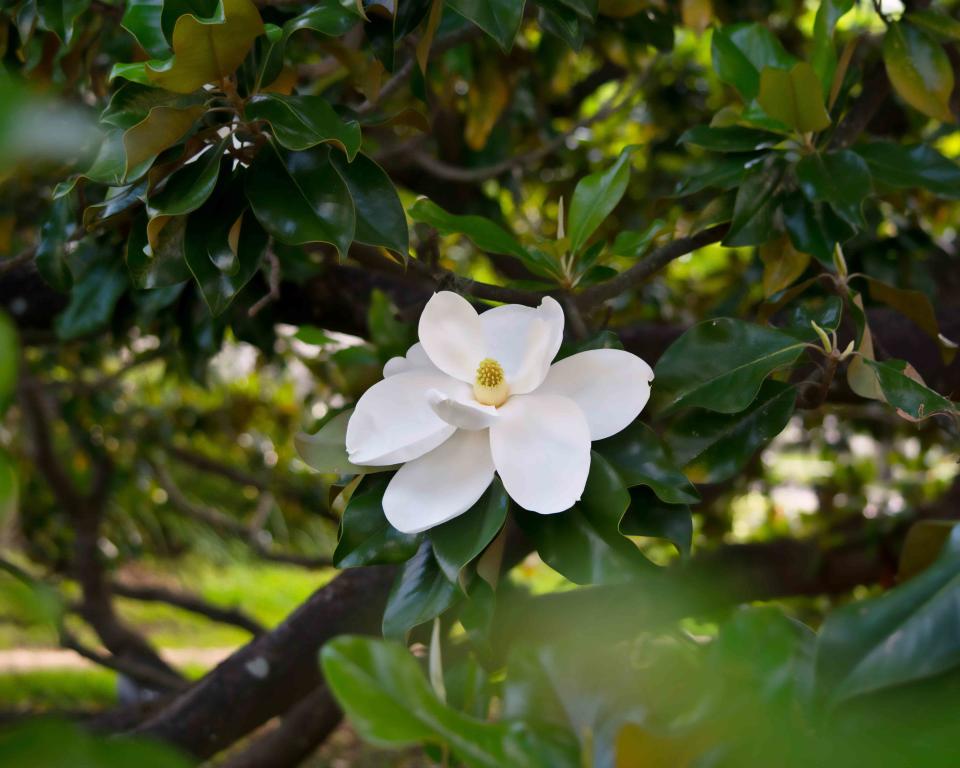
Getty Images / Dwbenjam
Trees are an essential component of landscapes and communities, and provide numerous services. They clean the air we breathe, enhance property values, and create a sense of peace and tranquility. Flowering trees are a boon to birds, bees, and butterflies, providing essential food and shelter. From a design standpoint, flowering trees serve as focal points and accents to compliment the home’s architecture and the gardens surrounding it. White flowers in particular stand out against green foliage to brighten sunny borders and woodland gardens. The 15 white flowering trees featured here bloom at different times of the year, so there’s always an eye-catching display.
Tips for Selecting a White Flowering Tree for Your Yard
When selecting flowering trees, consider the mature size and plan accordingly. Some of the trees on this list grow quite large, such as southern magnolia, and may not be suitable for all landscapes, though compact selections are available. Also consider design elements. In addition to blooms, these selections feature interesting bark, colorful fruits, and fabulous fall foliage to enhance the garden all year long. And if you are looking to attract birds and butterflies, consider one of the many native selections featured.
Related: 6 Trees You Should Never, Ever Plant
Flowering Dogwood
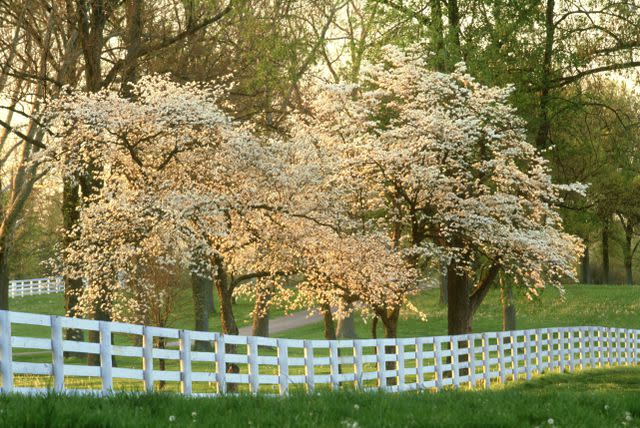
Getty Images / Adam Jones
Botanical Name: Cornus florida
Sun Exposure: Full Sun to Partial Shade
Soil Type: Moist, Well-draining, Organically Rich
Soil pH: Slightly Acidic (5.5-6.0)
A staple of woodland gardens throughout the south, native dogwood trees are breathtaking in bloom. The four showy white petals of each blossom are actually bracts or modified leaves that surround the true flowers—small yellow-green blooms that attract bees and butterflies. Showy red fruits appear in fall before the foliage turns a striking burgundy red to purple hue. With tiered branches, dogwoods make stunning specimens that mature to 15 to 25 feet tall and wide.
Serviceberry
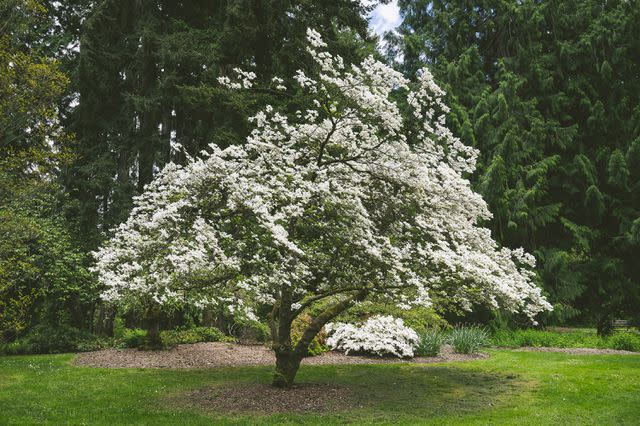
Getty Images / Cavan Images
Botanical Name: Amelanchier spp. and hybrids
Sun Exposure: Full Sun to Partial Shade
Soil Type: Moist, Well-draining
Soil pH: Slightly Acidic to Neutral (5.5-7.0)
Serviceberry is one of several common names for trees in the genus Amelanchier, most of which are native to North America. These small trees come into bloom mid-March to April, depending on the species, with white flowers followed by purple fruits. The fruits are edible, but you’ll have to beat the birds to them, as they are adored by bluebirds, cardinals, robins, and other songbirds. Serviceberry trees are quite adaptable to different soils and moisture regimes. The Amelanchier x grandiflora hybrids such as 'Autumn Brilliance' and 'Ballerina' have greater resistance to foliar diseases such as fire blight and leaf spot than do the species., making them quite popular. Most serviceberry species grow 10 to 25 feet tall and 10 to 15 feet wide.
American Fringetree
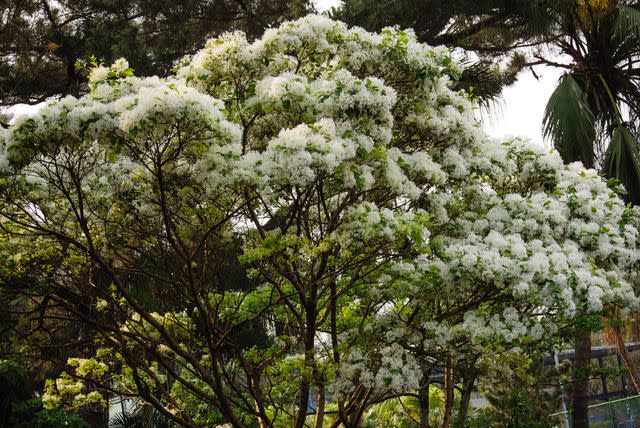
Getty Images / RichieChan
Botanical Name: Chionanthus virginicus
Sun Exposure: Full Sun to Partial Shade
Soil Type: Well-draining, Average to Rich
Soil pH: Acidic to Neutral (5.0-7.0)
Strappy, fringe-like flower petals give this native tree its common name. The fragrant blooms emerge in late spring, unfurling their long white petals to flutter in the wind . American fringetrees are dioecious, meaning male and female flowers appear on separate plants. The male flowers tend to be showier, though both male and female trees are quite spectacular in bloom. American fringetree is adaptable to a range of soils, including clay, but does not tolerate salt. Trees produce a rounded crown atop either a single trunk or, more commonly, a multi-branched trunk, and grow 12 to 20 feet tall and wide.
Southern Magnolia
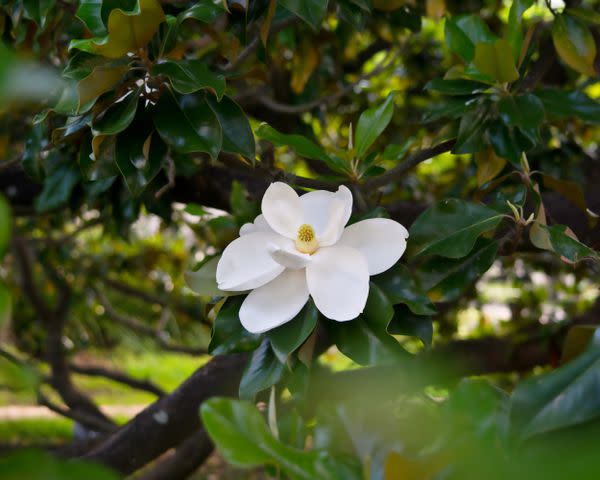
Getty Images / Dwbenjam
Botanical Name: Magnolia grandiflora
Sun Exposure: Full Sun to Partial Shade
Soil Type: Moist, Well-draining, Rich
Soil pH: Slightly Acidic (5.5-6.5)
Southern magnolia is a broadleaf evergreen adored for its gorgeous glossy, dark green foliage and large heaven-scented summer blooms. Native to moist woodlands and bottomlands along the coastal plains, southern magnolia thrives in rich, moist soils. It is also quite well adapted to large landscapes, where trees take on a stately pyramidal form, holding their limbs almost to the ground. The tree’s large size (60-80 feet tall by 30-50 feet wide) overwhelms many landscapes.
Fortunately, several compact varieties are available including 'Teddy Bear' which grows 15 to 20 feet tall and only spreads 10 feet wide.
White Redbud
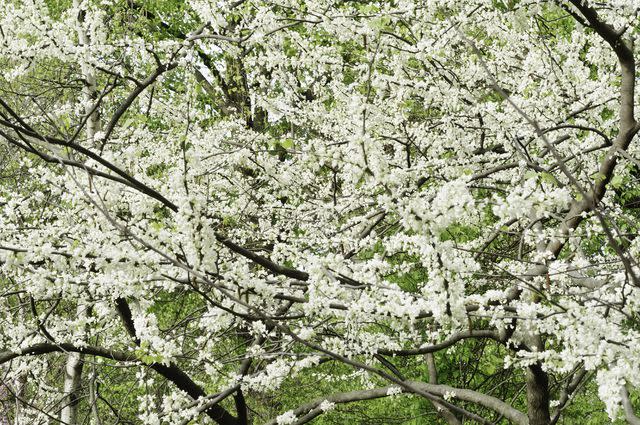
Getty Images / kschulze
Botanical Name: Cercis canadensis cultivars
Sun Exposure: Full Sun to Partial Shade
Soil Type: Well-draining, Rich
Soil pH: Acidic to Alkaline (5.0-8.0)
Redbuds are named for the color of the unopened flower buds, not the blooms themselves, which are typically purple or dark pink. However, several varieties produce pure white blooms including 'Royal White', 'White Pom Poms', and 'Texas White'. On all varieties, a plethora of pea-like flowers cover the branches before the heart-shaped foliage emerges. Twelve species of butterflies and moths use redbud trees as a host plant, including Henry’s elfin butterflies. This low-maintenance tree adapts well to drier soils and tolerates heat. Plants mature to 15 to 25 feet tall and wide.
Crepe Myrtles
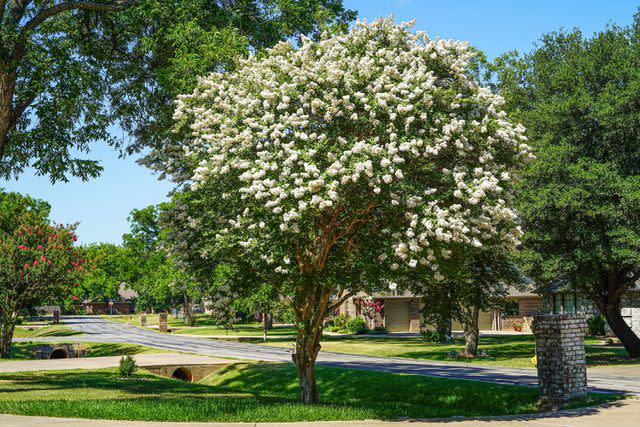
Getty Images / Christine Kohler
Botanical Name: Lagerstroemia indica
Sun Exposure: Full Sun
Soil Type: Dry to Moist, Well-draining
Soil pH: Acidic to Alkaline (5.0-8.0)
Flowering July through September, numerous soft, papery blooms cover crepe myrtles for months on end. Many white-flowered cultivars are available ranging in size from 6 to 30 feet tall, with plants loosely classified by size as dwarf, semi-dwarf, medium, or tall. In addition to the gorgeous blooms, crepe myrtles grow in a lovely vase shape adding a graceful accent to the landscape. A handful of varieties produce white blooms against dark red or purple foliage for incredible color and contrast.
Star Magnolia
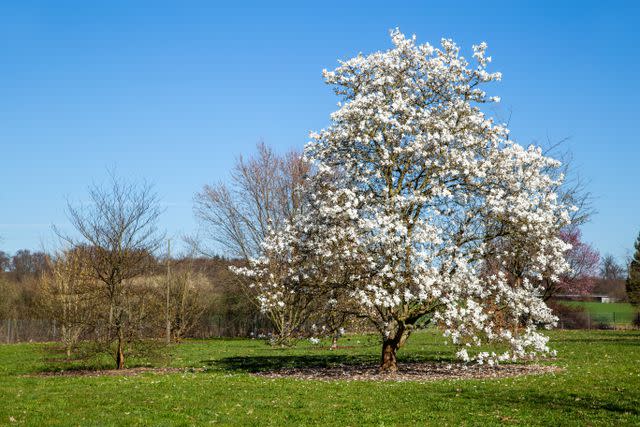
Getty Images / BasieB
Botanical Name: Magnolia stellata
Sun Exposure: Full Sun to Part Shade
Soil Type: Moist, Well-draining, Rich
Soil pH: Slightly Acidic (5.5-6.5)
Star magnolia is a deciduous relative of southern magnolia that produces dramatic flower displays in early spring before the leaves emerge. Because flowers bloom early in the season, they can be prone to damage by late spring frosts. Limit damage by planting in a protected location and avoid southern exposures, which can cause the flowers to open too early. Star magnolia’s compact size, 15 to 20 feet tall and 10 to 15 feet wide, makes it a good selection for smaller landscapes. In winter, the gray branches pose a striking silhouette against a dark backdrop.
Crabapple
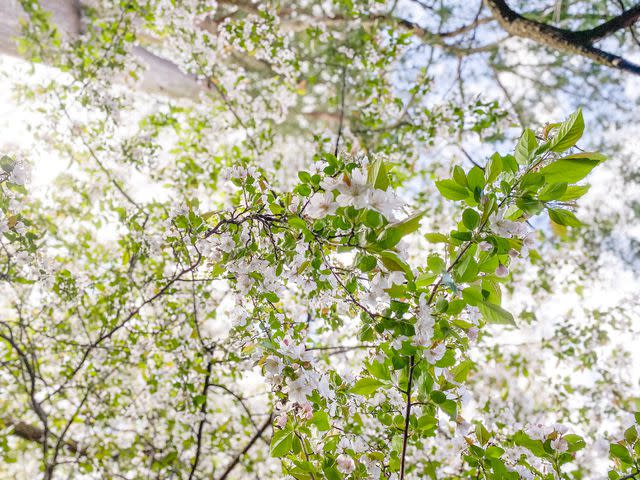
Getty Images / Catherine McQueen
Botanical Name: Malus species and hybrids
Sun Exposure: Full Sun
Soil Type: Medium to Moist, Well-draining, Average to Rich
Soil pH: Slightly Acidic to Neutral (5.8-7.2)
Clouds of 5-petaled blossoms cover crabapple trees mid-spring, filling the air with sweet fragrance. A diversity of white-flowered varieties is available, most opening from pink buds with crowns ranging from vase-shaped to rounded. The abundance of cultivars allows you to find the best match for your gardening goals. If maintenance is a concern, look for sterile varieties that do not produce fruits. Other varieties yield an abundance of yellow to red fruits that are adored by birds. Apples and their relatives are notorious for foliar diseases. Look for disease resistant cultivars to limit common problems.
Southern Catalpa
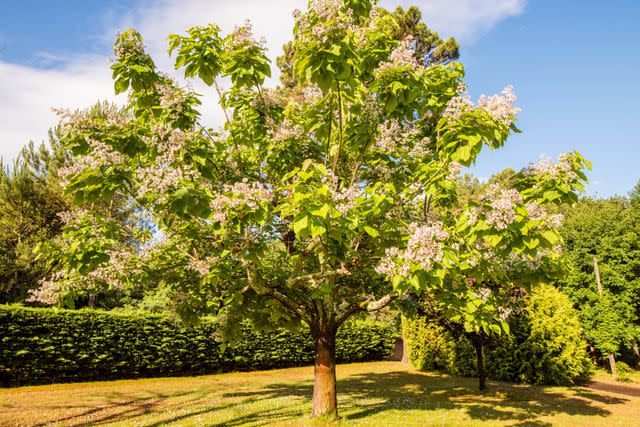
Getty Images / DEBOVE SOPHIE
Botanical Name: Catalpa bignonioides
Sun Exposure: Full Sun to Part Shade
Soil Type: Medium, Well-draining, Rich
Soil pH: Slightly Acidic to Neutral (5.5-7.5)
The orchid-like blooms of catalpa trees are wonderfully fragrant and incredibly showy. Opening early to late summer, the throat of each bell-shaped flower bears yellow streaks and numerous purple spots. Southern Catalpa is an easy-to-grow shade tree that grows 30 to 60 feet tall and 20 to 40 feet wide and produces large, heart-shaped leaves. The long, cigar-shaped seed pods make for a unique display in fall and winter. Native to the southeast, this adaptable tree tolerates clay soils, and both wet and dry conditions, including occasional flooding.
Seven-Son Flower
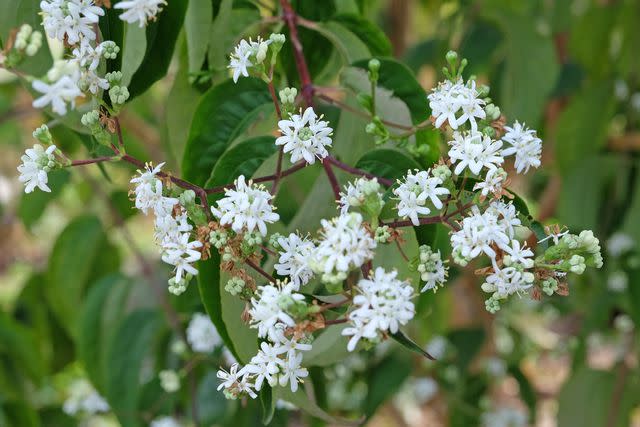
Getty Images / Alex Manders
Botanical Name: Heptacodium miconioides
Sun Exposure: Full Sun to Part Shade
Soil Type: Medium, Well-draining, Rich
Soil pH: Slightly Acidic to Neutral (5.5-7.0)
This small, multi-stemmed tree dazzles all year long, making it an excellent specimen. Glossy foliage emerges in spring and stays clean and attractive all
season. The fragrant, nectar-rich blooms open in late summer and last for several weeks, attracting hummingbirds, butterflies, and bees to the garden. Sturdy, petal-like calyces remain after the flowers fall, giving the appearance of a second flush of rosy to cherry-red blooms. Plants continue to shine through the winter months when the exfoliating bark takes center stage. All this while taking up little space in the garden: seven-son flower trees mature at 10 to 20 feet tall and just 8 to 10 feet wide.
Mexican Plum
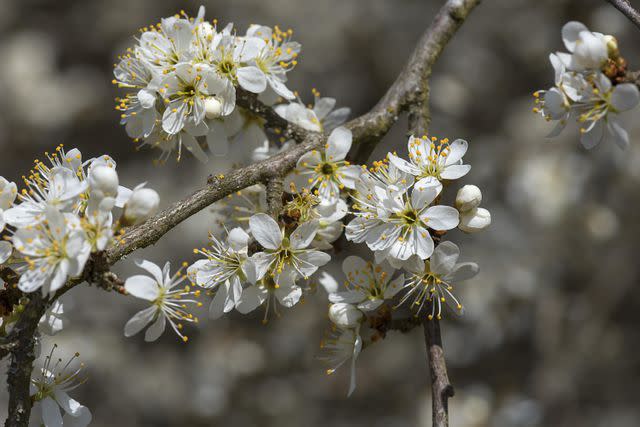
Getty Images / imageBROKER/Helmut Meyer zur Capellen
Botanical Name: Prunus mexicana
Sun Exposure: Full Sun to Part Shade
Soil Type: Dry to Medium, Well-draining, Average to Rich
Soil pH: Slightly Acidic to Neutral (5.5-7.5)
Several native plum species make their home across the southern states, but Mexican plum is among the most landscape-friendly. While some plums sucker profusely, Mexican plum produces a single trunk. Fragrant white blooms cover the bare branches in spring, followed by edible purple fruits that ripen in early autumn. Mexican plum is an excellent wildlife tree, providing food and shelter for birds, nectar and pollen for pollinators, and serving as a host plant to several butterfly species including tiger swallowtails.
'Sweet Tea' Mountain Gordlinia
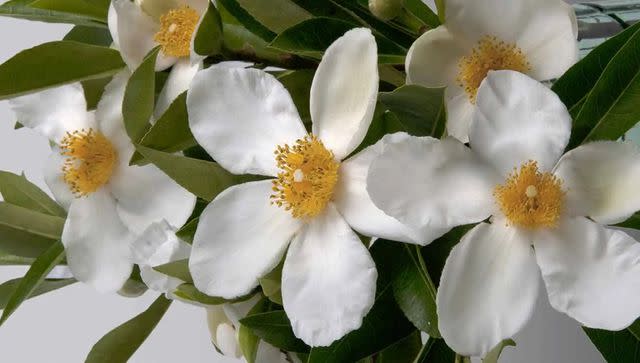
Southern Living Plant Collection
Botanical Name: x Gordlinia grandiflora 'Sweet Tea'
Sun Exposure: Morning Sun and Afternoon Shade
Soil Type: Moist, Well-draining, Rich
Soil pH: Acidic (5.0-6.0)
This rare hybrid of two native southern trees, Franklinia and Gordonia, is not the easiest tree to grow, but it rewards diligent gardeners with sweet smelling blooms July through September. The 5-inch flowers boast a golden yellow center, much like camellias, and attract pollinators. Plant this showy specimen near walkways or patios where the scent can be enjoyed. Mountain Gordlinia is semi-evergreen, with some foliage falling in autumn and the remaining leaves taking on a
red-orange hue. Provide this plant protection from hot afternoon sun.
Carolina Silverbell
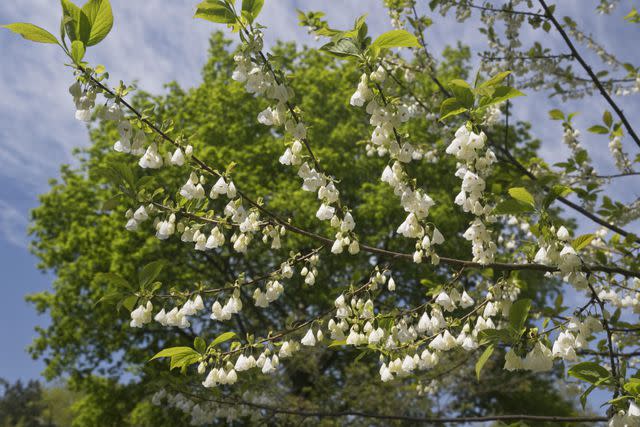
Getty Images / imageBROKER/Erhard Nerger
Botanical Name: Halesia carolina
Sun Exposure: Filtered Sun to Part Shade
Soil Type: Medium to Moist, Well-draining, Average to Rich
Soil pH: Slightly Acidic to Neutral (5.0-7.0)
Carolina silverbell is a native understory tree found throughout the southern
Appalachian Mountains. White, pendulous blooms appear in drooping clumps from April to May and attract hummingbirds, butterflies, and bees. Songbirds feast
on the developing buds and flowers, and the tree serves as a host plant to
numerous butterflies including mourning cloak, viceroy, and eastern tiger swallowtails. Perfect for woodland gardens, Carolina silverbell makes a great companion for azaleas and rhododendrons and is very long-lived. Plants are sensitive to heat and drought, so plan accordingly.
Japanese Stewartia
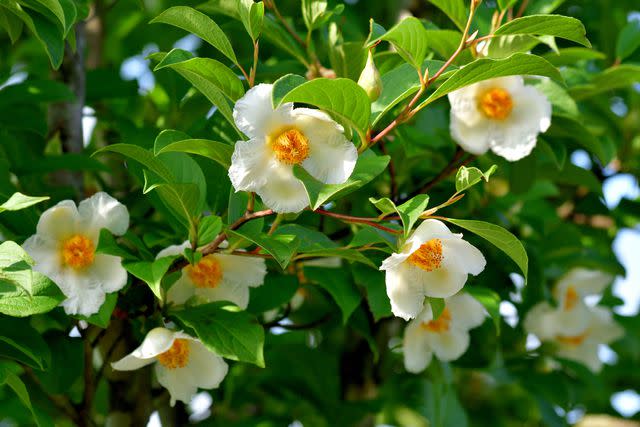
Getty Images / magicflute002
Botanical Name: Stewartia pseudocamellia
Sun Exposure: Full Sun to Part Shade
Soil Type: Moist, Well-draining, Rich
Soil pH: Acidic (4.5-6.5)
Southern gardeners adore Japanese Stewartia for its vibrant camellia-like blooms, gorgeous fall color, and colorful peeling bark. This medium-sized, multi-stemmed tree reaches a height of 15 to 40 feet tall and spreads 10 to 25 feet wide. The canopy is broadly oval to pyramidal, producing a shapely specimen. Plants bloom throughout the summer and turn vibrant yellow, red, and purple hues come fall. Provide sandy or loamy soil and protection from winter winds.
Lily of the Valley Tree
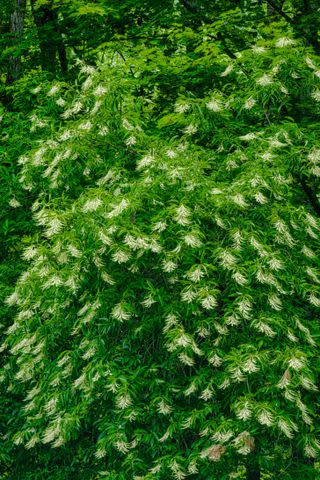
Getty Images / jlwhaley
Botanical Name: Oxydendrum arboreum
Sun Exposure: Full Sun to Part Shade
Soil Type: Moist, Well-draining, Rich
Soil pH: Acidic (4.0-6.5)
The aptly named lily of the valley tree produces large panicles of fragrant, bell-shaped blooms that hang in long chains for several weeks mid-summer. The flowers are highly attractive to bees and produce delicious honey sought by connoisseurs. Yellow fruit capsules are almost as showy as flowers and persist into winter. In autumn, the fruits turn a silver color that shines against the brilliant crimson-red fall foliage. Saplings slowly grow into a medium-sized, pyramidal tree reaching 20 to 30 feet tall and 10 to 15 feet wide.
For more Southern Living news, make sure to sign up for our newsletter!
Read the original article on Southern Living.

